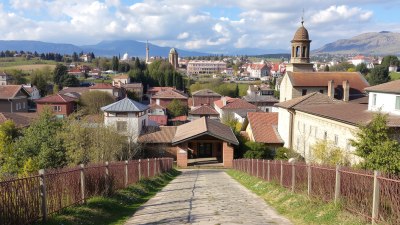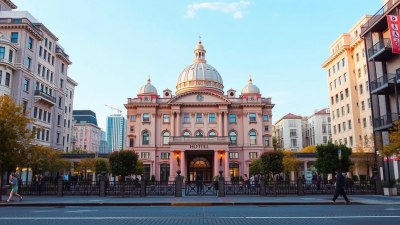The Path Between Wars in Gori, Georgia
Explore the historical significance of Gori, Georgia during the interwar period.

Gori, a city in Georgia, is steeped in history and intertwined with significant events between the two major conflicts of the 20th century, namely World War I and World War II. Nestled in the heart of the Caucasus region, Gori holds a strategic location that has seen the rise and fall of empires, making it a focal point of study for those interested in the complexities of Georgia's past.
This article delves into Gori's historical context, examining its role during the interwar years, the socio-political dynamics, and the lingering effects of the conflicts that shaped not only the city but also the nation of Georgia. The interwar period, often overshadowed by the wars themselves, is crucial for understanding the evolution of Gori and its place in Georgian history.
A Brief Historical Overview of Gori
Historically, Gori has been recognized as an essential settlement since ancient times. Its geographical location contributed to its strategic significance, as it served as a pivotal point for trade and military operations. Throughout history, Gori has been subjected to various rulers and empires, including the Kingdom of Iberia, Persia, and the Russian Empire. However, it was in the early 20th century that Gori began to take on a new importance in the context of national identity and political change.
The city became particularly notable in the aftermath of the Russian Revolution in 1917, which set off a wave of revolutionary activities across the former Russian Empire. Gori played a role in the tumultuous political shifts that followed, as various factions, including socialist and nationalist movements, vied for power.
Gori's Transformation During the Interwar Period
Between the two world wars, Gori underwent significant transformations influenced by the broader political climate in Georgia and the Soviet Union. After the Bolshevik takeover, Georgia experienced a brief period of independence from 1918 to 1921, during which Gori emerged as a center for nationalist aspirations. The city saw increased political activism, with various groups advocating for autonomy and independence.
However, this period of independence was short-lived. In 1921, the Red Army invaded Georgia, leading to its incorporation into the Soviet Union. This marked a turning point for Gori, transitioning from a symbol of hope for independence to a cog in the Soviet machinery. The establishment of Soviet control brought about widespread changes in administrative structures, economic policies, and social dynamics.
The Impact of Soviet Policies on Gori
The incorporation of Gori into the Soviet Union had profound implications for its development. The Soviet regime implemented policies aimed at transforming Gori into a model socialist city. This included industrialization efforts, the collectivization of agriculture, and the promotion of education and literacy. Gori was chosen for its geopolitical significance, leading to significant investment in infrastructure and public services.
However, these changes were not without their challenges. The forced collectivization, in particular, met with resistance from the local populace, as traditional farming practices were disrupted. Many families faced hardships due to the policies, which often prioritized state needs over individual welfare. Nonetheless, Gori began to evolve, reflecting the Soviet vision of urban development.
Social Changes in Gori during the Interwar Years
The interwar period also brought about shifts in the social fabric of Gori. The promotion of gender equality and women's rights became prominent under Soviet influence. Educational initiatives encouraged women to participate in the workforce, leading to increased visibility and agency in public life. Nevertheless, traditional societal norms continued to persist, resulting in a complex interplay between modernity and tradition.
Despite these advancements, life in Gori during the interwar period was marked by ideological and political repression. The Stalinist purges of the 1930s resulted in a climate of fear and suspicion, affecting citizens' everyday lives. Many were subjected to surveillance, and dissent was ruthlessly quashed. Such repression left a profound impact on Gori's collective psyche, creating a legacy of trauma that would resonate beyond the 20th century.
Economic Development and Challenges
Economically, Gori experienced both growth and hardship during the interwar period. Soviet policies aimed at industrialization led to the establishment of factories and production facilities, which created job opportunities for locals. The growth of industries such as textiles and machinery altered Gori's economic landscape, transitioning it from an agrarian society to an industrial one.
However, these developments were not entirely beneficial. The rapid pace of industrialization often led to poor working conditions and environmental degradation. Additionally, the emphasis on heavy industry meant that essential services and consumer goods were frequently neglected. The citizens of Gori faced a paradox: while there were more job opportunities and economic activity, the quality of life often diminished due to the demands of the state.
Gori and the Path to World War II
As Gori continued to evolve during the interwar period, it became increasingly connected to the larger geopolitical tensions that would eventually lead to World War II. The rise of fascism in Europe had global repercussions, and the Soviet Union's response to these threats influenced the strategies employed in Gori and across Georgia.
The city was used as a strategic military base, reflecting its importance in the Soviet defense strategy. As the shadow of another war loomed closer, Gori also became a site for propaganda efforts aimed at bolstering Soviet morale. Artistic representations, literature, and educational curricula emphasized the narrative of the Soviet Union as a bastion against capitalist imperialism.
The Legacy of the Interwar Period in Gori
The interwar years left an indelible mark on Gori, shaping its identity and collective memory. The struggles for independence, the imposition of Soviet control, and the complexities of social change during this turbulent period fostered a unique spirit among Gori's residents. This rich history continues to inform the narrative of Gori today, as the city grapples with its past while looking to the future.
Post-World War II, Gori emerged in a different global context, still burdened by the weight of its history. The traumas experienced during the interwar years, coupled with the developments of World War II, created a nuanced landscape for its citizens. As Gori navigates contemporary challenges and celebrates its heritage, the lessons learned from the past remain crucial in shaping its identity.
Contemporary Reflections on Gori's Historical Journey
Today, Gori stands as a testament to resilience and transformation. The interwar period, a critical chapter in its history, is often revisited in discussions about national identity, post-Soviet recovery, and regional dynamics. Museums, educational institutions, and community initiatives strive to preserve the memory of those tumultuous years, ensuring that the stories of struggle, perseverance, and change remain alive.
Moreover, Gori's experience serves as a lens through which broader themes of conflict, governance, and societal shifts can be examined. As the world continues to change, Gori's path between wars offers critical insights and reflections on the complexities of navigating a contested identity and history.











